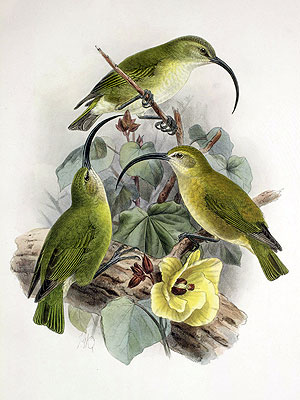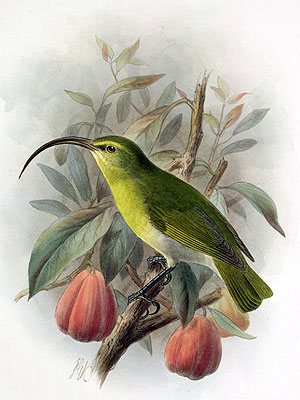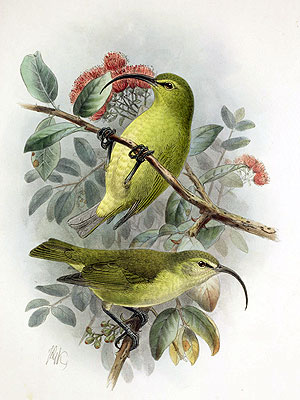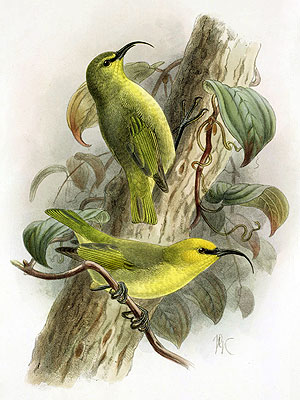Maui-nui Akialoa (Hemignathus lanaiensis)
The Maui-nui Akialoa aka. Lanai Akialoa was historically only known from the island of Lana’i, Hawaiian Islands, but did formerly also occur on the neighboring islands of Maui and Moloka’i as its known based on subfossils (found at least on Maui). [2]
The species is known by exactly three specimens, two of which appear to be sub-adult males and the third one a female. [3]
***
There is an interesting account made in 1903 (?) by Robert Cyril Layton Perkins, a British entomologist, naturalist and ornithologist about this species in life.:
“Almost equally unfortunate was my experience of H. lanaiensis, of which I saw but a single example. This was evidently an adult male, its plumage appearing quite brightly yellow, and unlike any of the figures in Mr Rothschild’s work. There is no doubt hat his figure of the adult bird, if really taken from an adult, represents the bird in its non-breeding stage, for in January, when I saw the one above mentioned, all the adult birds on Lanai were in the fullest and most perfect plumage. It was extremely tame, at times not five yards distant, hunting for insects along the trunk and large limbs of a partly fallen Ohia, which overhung the edge of a precipitous cliff. As, if killed, it would necessarily have fallen in the brush far below, or have lodged in the shrubbery on the side of the cliff, being without a dog I forbore to shoot, and when after some minutes it flew off, it was seen no more. It is probable that this was realy a survivor of the brood obtained by Mr Rothschild’s collectors, since Wolstenholme, who discovered the bird, informed me that all of their specimens were obtained in the same spot and practically at the same time. Certainly the bird seen by me was quite alone, and this at a time when mature birds were all paired, and it may even be feared that it was the sole living representative of its species.” [1]
The Maui-nui Akialoa was extinct shortly after.
*********************

Depiction from: ‘W. Rothschild: The Avifauna of Laysan and the neighbouring islands with a complete history to date of the birds of the Hawaiian possession. 1893-1900’
(public domain)
*********************
References:
[1] R. C. L. Perkins: Vertebrata. in: Fauna Hawaiiensis 1(4): 365-466. 1899-1913
[2] S. L. Olson; H. F. James: Descriptions of thirty-two new species of birds from the Hawaiian Islands: Part II. Passeriformes. Ornithological Monographs 45: 1-91. 1991
[3] H. D. Pratt: The Hawaiian Honeycreepers: Drepanidinae. Oxford Univ. Pr. 2005
*********************
edited: 09.10.2020




